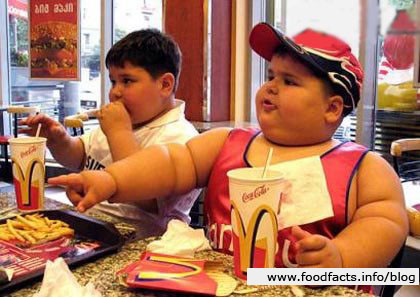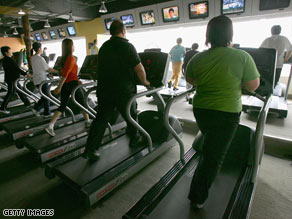Nora Cara was flabbergasted.
She was about to order her usual morning coffee and muffin at Dunkin’ Donuts when she saw the new calorie labels. The chocolate chip muffin she had her eye on was 630 calories.
“I was blown away,” said Cara, a 27-year-old homemaker from Forest Hills in New York City. “I’m not a no-carb type of person, and I usually don’t even think about it. But you pick up a little muffin with your coffee, and it has 630 calories in it? That’s a bit extreme!”
New Yorkers have been in the throes of sticker shock since this spring when the Big Apple became the first city in the country to implement a law forcing chain restaurants to post the calorie count of each food in the same size and font as the price.
Restaurants have not exhausted their legal challenges, but the city will start fining violators up to $2,000 beginning Friday, say officials with the city’s Department of Health and Mental Hygiene.
While some sit-down chains and fast-food eateries are waiting until the last minute, coffee shops like Starbucks — home of the 470 calorie raspberry scone and 610 calorie cookie — have been replacing their menu boards and adding calorie tags to pastries in recent weeks. The result: Do a little eavesdropping in a New York City restaurant, and you may think you’ve stumbled into an Overeaters Anonymous meeting.
At T.G.I. Friday’s, one of the few sit-down chain restaurants to have already added calorie counts to menus, a group of young women gasped as they studied the menu, barely able to find a meal under 1,000 calories, never mind an appetizer or dessert. Both Stephanie Fowler and Lindsay Green asked about the suddenly popular Classic Sirloin — at 290 calories, it was one of the lowest calorie items on the menu — but learned the restaurant ran out by the time the dinner rush started.

Outside the Forest Hills’ Dunkin’ Donuts, Juan Restrepo, the 45-year-old owner of a construction company, said he was quitting corn muffins — 510 calories! — this time for good.
“My daughter warned me about them,” he lamented. “I just didn’t listen.”
Preventing diabetesPutting the brakes on thoughtlessly inhaling calories is exactly the effect New York City health officials hoped the law would have. They say calorie labels could reduce the number of obese New Yorkers by 150,000 over the next five years, and prevent 30,000 cases of diabetes.
New York is not the only city pushing calorie labels. New laws in Seattle and California’s Santa Clara and San Francisco are scheduled to go into effect later this year, including some more stringent than New York’s, requiring restaurants to post information about sodium, carbs, fats and cholesterol in addition to calories.
Such laws have faced stiff opposition and legal challenges from the restaurant industry. A judge
struck down New York City’s first calorie labeling law, which would only have applied to fast food restaurants that were already making calorie information available on Web sites or posters. The law was then revised to apply to all chain restaurants with 15 or more outlets nationwide.
“We’re still in court, but the ruling is in effect,” said New York City health department spokeswoman Jessica Scaperotti. Fines for the restaurants who haven't posted calorie counts by Friday will range from $200 to $2,000 depending on the violation, she said.
Scaperotti said she didn't know what impact the calorie labels have made on consumer choices or sales. But, she said, “We know nutritional information is effective. If you go to the Starbucks near our office in lower Manhattan, the little cookies that are 80 calories each — they’re the first ones to go.”
1,360 calorie salad Many New Yorkers are finding that even the foods they thought were lower calorie really aren’t. Vicki Freedman, who lives in Manhattan, watches her weight and always tries to choose a light option when eating out. But the 26 year old just discovered that the Friday’s pecan-crusted chicken salad, served with mandarin oranges, dried cranberries and celery, has 1,360 calories.
“That surprised me the most because they market it as a healthy option,” she said. “It’s like false advertising. You think it’s better than the burger and the fries. It’s misleading.” (The cheeseburger served with fries is, indeed, 1,290 calories.)
Meals ordered at sit-down chain restaurants may have more calories than typical takeout fast-food, nutritionists say, because the portions are often larger and an entrée can be served on a plate smothered with French fries. In a takeout restaurant, the fries have to fit into a container, which limits the portion size.
Managers at some restaurants, including an Upper East Side Johnny Rocket’s and Outback Steakhouse, said new menus including calorie counts would be on tables by Friday, or shortly thereafter.
“We’re concerned,” acknowledged Eric Hagy, proprietor of Outback Steakhouse on Third Avenue in Manhattan. “I don’t know what effect it will have, but it will bring people’s attention to certain items that are high in calories, like the Bloomin’ Onion appetizer. It has over 2,000 calories, but it’s meant to be shared between two or three people.”
At a Starbucks on the Upper East Side of Manhattan, barista Bishoy Ayoub, 18, said he’s noticed many customers switching to smaller drinks or reduced-fat drinks since calorie labels were posted several months ago.
‘Take off the labels’“Some people actually tell us we should take off the labels, because it discourages them from ordering what they want,” he said. “But I think honesty is the best policy.”
At a Wendy’s nearby, where calorie counts were just posted next to prices on the menu-boards behind the counter, customers didn’t flinch. “I figure I’ve got 1,350 calories here on my tray,” said Tristan Rowe, 26, who lives in Brooklyn, pointing to his lunch of a chicken club sandwich, junior bacon-cheeseburger, large fries and a large Coke (which actually added up to 1,680 calories). “It’s not going to change what I order — I’m not watching my waistline. I have a very active lifestyle.”
Despite the eye-opening revelations, whether New Yorkers will switch to lower calorie meals remains to be seen. They may just switch menus.
That’s what Fowler, the woman who was dining recently with her friends at T.G.I. Friday's, decided to do.
“I’m so upset,” she said, noting some entrees — like the Jack Daniels ribs and shrimp dinner — contain almost 2,000 calories, and the desserts were more of the same (the brownie obsession is 1,500 calories). “I wish they wouldn’t have done this.”
But then Fowler noticed that the waiter had handed her friend an old menu, which didn’t have calorie counts on it.
“You got a menu without anything on it?” she asked her friend. “Can I have yours?”
Roni Caryn Rabin is a health writer who lives in New York City. She has written for The New York Times, The Washington Post, Newsday and Real Simple magazine, among other publications, and is author of the book, "Six Parts Love: A Family's Battle with Lou Gehrig's Disease." She teaches journalism at the Columbia University Graduate School of Journalism.
© 2008 MSNBC Interactive


























